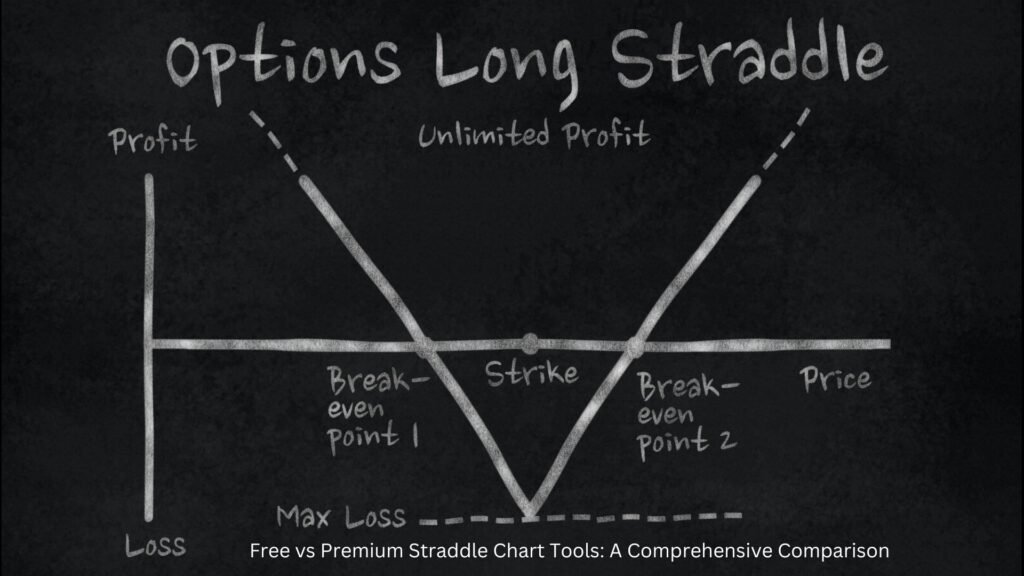
Get easy-to-follow, expert stock market tips that can help you earn more.
📈 Click here for smart, reliable advice! ✨
Straddle Chart 2024: Visualize & Earn in Options
SHARE
Are you ready to take your options trading to the next level in 2024? The Straddle Chart is here to help you visualize and maximize your earnings. In this article, we’ll explore what the Straddle Chart is and how it can revolutionize your options trading strategies.

What is the Straddle Chart?
Understanding the Basics: A Straddle Chart is a powerful tool used in options trading.
Simultaneous Actions: It involves the simultaneous purchase of both a call and a put option with the same strike price and expiration date.
Managing Uncertainty: Traders use this strategy when they expect significant price volatility but are uncertain about the direction of the movement.
The Importance of Straddle Chart in Options Trading
Risk Management: Straddle Charts allow traders to manage risk effectively by creating a balanced position.
Profit Potential: They offer the potential for substantial profits regardless of whether the market goes up or down.
Versatility: Straddle Charts can be applied to various assets and market conditions.
Analyzing Nifty and Bank Nifty with Straddle Charts
Navigating Bank Nifty Straddle Charts: Learn how to use Straddle Charts specifically for trading Bank Nifty.
Leveraging Nifty Straddle Chart: Discover how Nifty Straddle Charts can provide valuable market insights.
Exploring Tools and Software for Straddle Chart Analysis
Best Software for Straddle Chart Analysis: Stay up-to-date with the latest software options for Straddle Chart analysis in 2024.
Free vs. Premium Straddle Chart Tools: Understand the pros and cons of both to make an informed choice.
Advanced Techniques in Straddle Chart Analysis
What is the Straddle Chart?
The Straddle Chart is a vital tool in the realm of options trading, offering traders a unique strategy for handling market volatility. In this article, we’ll break down what a Straddle Chart is and how it functions to empower your trading decisions.
Understanding the Basics:
Simultaneous Actions:A Straddle Chart involves the simultaneous purchase of both a call and a put option.
Same Parameters:These options share the same strike price and expiration date.
Handling Uncertainty: Traders utilize this strategy when they anticipate significant price fluctuations but are uncertain about the direction of the movement.
How Does It Work?
Neutral Position: The Straddle strategy creates a neutral position, which means it doesn’t rely on the market moving in a specific direction.
Profit Potential: It offers profit potential from both upward and downward market movements.
Risk Management: Traders can limit their potential losses while preserving the opportunity for substantial gains.
When to Use Straddle Charts?
Earnings Announcements: Straddle Charts are often employed ahead of earnings announcements or major news events.
Volatility Anticipation: Traders use Straddle Charts to capitalize on anticipated market volatility.
Uncertain Market Conditions: In times of uncertainty, Straddle Charts provide a safeguard against unforeseen price swings.
In conclusion, the Straddle Chart is a valuable tool for traders seeking to navigate uncertain market conditions and capitalize on volatility. By simultaneously holding call and put options, traders can position themselves strategically to profit, regardless of the market’s direction. Understanding the Straddle Chart is essential for those looking to enhance their options trading toolkit.
Understanding the Basics of Straddle Chart and Its Applications
Straddle Chart Fundamentals: A Straddle Chart involves the simultaneous purchase of a call and a put option with the same strike price and expiration date.
Neutral Strategy: It’s a neutral options trading strategy, meaning it doesn’t rely on market direction.
Handling Uncertainty: Traders use Straddle Charts when they expect significant price volatility but are unsure about the direction of the movement.
Profit Potential: This strategy offers the potential for profit whether the market goes up or down.
Risk Management: Straddle Charts help traders manage risk effectively by creating a balanced position.
Versatile Application: They can be applied to various assets and market conditions, making them a valuable tool for traders

Maximize Your Profits with Expert Calls!
Access expert stock calls for quick profits. Trade with confidence through BankNifty.today’s insights!
What is a Straddle Chart and How Does it Work?
Simultaneous Purchase: A Straddle Chart involves purchasing both a call and a put option simultaneously.
Shared Parameters: These options have the same strike price and expiration date, allowing for a direct comparison.
Neutral Strategy: Straddle Charts create a neutral trading position, meaning it doesn’t rely on predicting market direction.
Handling Volatility: Traders use Straddle Charts when they anticipate significant price volatility but are uncertain about whether it will go up or down.
Profit Potential: This strategy offers profit potential regardless of whether the market rises or falls.
Risk Management: Straddle Charts help traders manage risk effectively by maintaining a balanced position, limiting potential losses while preserving profit opportunities.
The Importance of Straddle Chart in Options Trading
Effective Risk Management: Straddle Charts allow traders to manage risk efficiently by creating a balanced position with both call and put options.
Profit Potential: This strategy offers the potential for substantial profits regardless of whether the market moves up or down.
Versatility: Straddle Charts can be applied to various assets and market conditions, making them a versatile tool for traders.
Adaptability: Traders can use Straddle Charts in anticipation of earnings announcements, news events, or during periods of high market uncertainty.
Neutral Position: Straddle Charts provide a neutral trading position, allowing traders to profit from volatility without speculating on market direction.
Information Gathering: They help traders gather valuable insights into market sentiment and expectations.
Analyzing Nifty and Bank Nifty with Straddle Charts
Straddle Charts are powerful tools that can be applied to various assets and market conditions. When it comes to analyzing specific indices like Nifty and Bank Nifty, these charts can provide invaluable insights. Let’s delve into how Straddle Charts can be used effectively in analyzing Nifty and Bank Nifty.
Navigating Bank Nifty Straddle Charts for Strategic Trading
Focused Analysis: Bank Nifty Straddle Charts allow traders to concentrate specifically on the banking sector, providing insights into this critical market segment.
Earnings Seasons: During earnings seasons, Bank Nifty Straddle Charts help traders prepare for potential price swings in banking stocks.
Leveraging Nifty Straddle Chart for Market Insights
Broad Market Perspective: Nifty Straddle Charts offer a broader view of the overall market, including sectors like IT, pharma, and FMCG.
Volatility Indicators: Traders can gauge market sentiment and volatility trends by analyzing Nifty Straddle Charts.
Incorporating Straddle Charts into your analysis of Nifty and Bank Nifty can enhance your trading strategies, allowing you to make more informed decisions in these key market indices. Whether you are trading specific sectors within Bank Nifty or seeking a comprehensive view of the broader market with Nifty, Straddle Charts provide a valuable perspective to guide your trading actions.
Navigating Bank Nifty Straddle Charts for Strategic Trading
Focused Insights: Bank Nifty Straddle Charts provide a concentrated view of the banking sector, enabling traders to make informed decisions within this crucial market segment.
Earnings Season Preparedness: During earnings seasons, these charts offer valuable insights into potential price fluctuations in banking stocks, allowing traders to strategize accordingly.
Risk Management: Straddle Charts assist in managing risk effectively by creating a balanced position with both call and put options, ideal for navigating the banking sector’s volatility.
Bank Nifty Straddle Charts are an indispensable tool for traders looking to navigate the intricacies of the banking industry and capitalize on its unique trading opportunities. Whether you’re a seasoned trader or just starting, these charts can be a game-changer in your strategic trading endeavors.

Get our Trading Tips for Free! 🎉
Sign up for our no-cost trial and see your trading improve.
Join our Telegram now!
Leveraging Nifty Straddle Chart for Market Insights
Comprehensive Market View: Nifty Straddle Charts offer a broad perspective on the overall market, encompassing various sectors like IT, pharma, and FMCG.
Volatility Indicators: Analyzing Nifty Straddle Charts allows traders to assess market sentiment and track trends in market volatility.
Informed Decisions: These charts empower traders to make well-informed decisions by providing valuable insights into potential market movements and sentiment shifts.
Whether you’re a seasoned trader seeking a comprehensive market overview or a newcomer looking to gather actionable insights, Nifty Straddle Charts serve as an invaluable resource for enhancing your trading strategies and decision-making processes.
Exploring Tools and Software for Straddle Chart Analysis
When it comes to Straddle Chart analysis, having the right tools and software at your disposal is essential. In 2024, there are various options to choose from, each offering unique features to aid in your trading endeavors. Let’s explore the best tools and software for Straddle Chart analysis:
Best Software for Straddle Chart Analysis: 2024 Edition
Option Analysis Software: Tools like OptionVue, OptionNet Explorer, and Thinkorswim offer advanced Straddle Chart analysis capabilities, including risk assessment and strategy optimization.
Trading Platforms Many popular trading platforms, such as MetaTrader and Interactive Brokers, provide built-in Straddle Chart analysis tools, making it convenient for traders to access these charts while executing trades.
Free vs. Premium Straddle Chart Tools: A Comprehensive Comparison
Free Tools: Platforms like TradingView and Yahoo Finance offer free Straddle Chart analysis tools, suitable for beginners or those on a budget. However, they may have limited features compared to premium options.
Premium Tools: Software like OptionNet Explorer and TradeStation come with a price tag but offer more advanced features, customization options, and in-depth analysis capabilities.
Having the right Straddle Chart analysis tool or software in your trading toolkit is crucial for making informed decisions and maximizing your trading potential. Whether you opt for free tools or invest in premium software, choose the one that aligns with your trading goals and expertise level to enhance your options trading experience in 2024.
Best Software for Straddle Chart Analysis: 2024 Edition
OptionVue: Renowned for its robust Straddle Chart analysis capabilities, OptionVue offers advanced risk assessment tools and strategy optimization features.
OptionNet Explorer: This software excels in Straddle Chart analysis, providing traders with comprehensive insights and customization options for refining their trading strategies.
Thinkorswim: Integrated into the thinkorswim trading platform, this tool offers Straddle Chart analysis alongside real-time trading, making it a convenient choice for active traders.
Selecting the best software for Straddle Chart analysis is essential for traders aiming to make informed decisions and optimize their options trading strategies in 2024. Evaluate these options based on your specific needs, expertise, and budget to enhance your trading experience effectively.
Free vs. Premium Straddle Chart Tools: A Comprehensive Comparison

Free Tools: Platforms like TradingView and Yahoo Finance provide free Straddle Chart tools, making them accessible to traders on a budget.
Limitations: Free tools may have limitations in terms of advanced features and customization options, potentially restricting in-depth analysis.
Premium Tools: Software like OptionNet Explorer and TradeStation come with a price tag but offer advanced capabilities, enhanced customization, and comprehensive analysis features.
Investment: Consider your trading goals, expertise level, and budget when choosing between free and premium Straddle Chart tools to ensure they align with your needs and objectives.
Advanced Techniques in Straddle Chart Analysis
Straddle Charts are powerful tools for options traders, and mastering advanced techniques in Straddle Chart analysis can significantly enhance your trading strategies. In this article, we’ll explore some advanced techniques to help you take full advantage of Straddle Charts.
Mastering Historical and Live Straddle Chart Analysis
Historical Data: Analyzing historical Straddle Charts allows traders to identify patterns and trends, enabling better predictions for future price movements.
Real-time Analysis: Incorporating real-time data into your analysis helps you react swiftly to changing market conditions and seize timely opportunities.
Strategies for Using ATM Straddle Charts in Day Trading
Implied Volatility: ATM (At The Money) Straddle Charts are valuable for day traders, as they reflect implied volatility. Understanding these charts can help day traders make informed decisions.
Gamma Scalping: Advanced day traders can employ gamma scalping techniques, adjusting Straddle positions to exploit market movements effectively.
Advanced Straddle Chart analysis goes beyond the basics, allowing traders to fine-tune their strategies and adapt to dynamic market conditions. By mastering historical and real-time analysis and implementing advanced day trading techniques, you can maximize the potential of Straddle Charts and elevate your options trading game to new heights.
Mastering Historical and Live Straddle Chart Analysis
Historical Data Analysis: Delving into historical Straddle Charts enables traders to identify recurring patterns and trends, enhancing predictive capabilities for future market movements.
Real-time Insights: Incorporating real-time data in Straddle Chart analysis equips traders with the ability to respond swiftly to rapidly changing market conditions, seizing timely opportunities.
Mastering the art of both historical and live Straddle Chart analysis is a crucial skill for options traders. By understanding past patterns and adapting to real-time market dynamics, traders can make more informed decisions, optimize their strategies, and ultimately improve their chances of success in the dynamic world of options trading.
Strategies for Using ATM Straddle Charts in Day Trading
Implied Volatility Insight: ATM (At The Money) Straddle Charts provide day traders with valuable insights into implied volatility, helping them assess potential price fluctuations.
Effective Gamma Scalping: Advanced day traders can leverage ATM Straddle Charts to implement gamma scalping strategies. This involves adjusting Straddle positions to capitalize on market movements effectively.
Using ATM Straddle Charts in day trading can be a game-changer. These charts offer a window into implied volatility, a critical factor in day trading decisions. Additionally, mastering gamma scalping techniques can help day traders adapt to rapidly changing market conditions and optimize their positions for maximum gains.
Comparative Analysis of Straddle vs. Strangle in Options Trading
Options trading provides a plethora of strategies, and two popular ones are the Straddle and Strangle. While they might sound similar, they have distinct characteristics and applications. In this article, we’ll conduct a comparative analysis of Straddle vs. Strangle strategies in options trading.
Decoding Strategies:
Straddle:
Components: A Straddle involves simultaneously buying both a call and a put option with the same strike price and expiration date.
Use: Traders employ Straddles when they anticipate significant price volatility but are uncertain about the direction of the movement.
Cost: Straddles can be more expensive due to buying two options.
Strangle:
Components: A Strangle consists of buying a call and a put option with different strike prices but the same expiration date.
Use: Strangles are used when traders expect substantial price movement but are unsure about the direction.
Cost: Strangles are typically cheaper than Straddles as they involve buying options with different strike prices.
Practical Applications:
Straddle:
Earnings Announcements: Straddles are popular before earnings reports, where price movements can be unpredictable.
Neutral Outlook: Effective when traders believe the market will experience significant movement, but they’re uncertain about the direction.
Strangle:
Volatility Plays: Strangles are suitable for capitalizing on volatile market conditions.
Non-Directional: Traders use Strangles when they expect a substantial price shift in either direction but don’t want to bet on a specific outcome.
In conclusion, the choice between Straddle and Strangle strategies depends on your market outlook, budget, and risk tolerance. Straddles offer a more direct bet on volatility, while Strangles are versatile and cost-effective for non-directional plays. Understanding their differences is crucial for effective options trading.
Decoding Straddle and Strangle Strategies: A Detailed Look
Straddle Strategy:
Involves buying both a call and a put option with the same strike price and expiration date.
Ideal for uncertain market conditions with anticipated significant price volatility.
Offers profit potential whether the market moves up or down.
Strangle Strategy:
Requires buying a call and a put option with different strike prices but the same expiration date.
Suitable when traders expect substantial price movement but are unsure about the direction.
Typically more cost-effective than Straddles due to differing strike prices.
Understanding the nuances of Straddle and Strangle strategies is crucial for options traders. These strategies offer distinct approaches to managing risk and capitalizing on market volatility, providing valuable tools for diverse trading scenarios.
Practical Applications of Straddle and Strangle Charts in Trading
Earnings Season: Straddles and Strangles are popular strategies leading up to earnings announcements when price movements can be unpredictable.
Volatility Plays: Traders use these strategies to capitalize on volatile market conditions, especially during economic events or news releases.
Neutral Outlook: Straddles work well when expecting significant movement but uncertain about the direction, while Strangles are versatile for non-directional plays.
Risk Management: Both strategies allow traders to limit potential losses by combining options, providing a safety net against unexpected market swings.
The practical applications of Straddle and Strangle charts in trading extend to various market scenarios, offering traders flexibility and risk mitigation while seeking profitable opportunities. Understanding when and how to use these strategies is essential for effective options trading.

Maximize Your Profits with Expert Calls!
Access expert stock calls for quick profits. Trade with confidence through BankNifty.today’s insights!
FAQ
How is a Straddle Chart different from other types of charts?
Difference from other types of charts: Straddle Charts are not a distinct chart type. Other common types of charts used in technical analysis include candlestick charts, bar charts, line charts, Renko charts, and more. Each of these chart types has its own characteristics and use cases.
What are the key components of a Straddle Chart?
Key components of a Straddle Chart: Since there is no standard Straddle Chart, there are no specific key components associated with it.
How do you create a Straddle Chart?
Creating a Straddle Chart: You don’t create a Straddle Chart; you implement a straddle trading strategy, which involves simultaneously buying a call option and a put option with the same strike price and expiration date.
What is the purpose of using a Straddle Chart in trading?
Purpose of using a Straddle Chart in trading: The purpose of implementing a straddle strategy is to profit from significant price movements in an underlying asset, regardless of whether it moves up or down. Traders use this strategy when they expect high volatility but are uncertain about the direction of the price movement.
Can you provide examples of when to use a Straddle Chart in financial analysis?
Examples of when to use a Straddle Chart:** A straddle strategy can be used before events that are expected to cause significant price volatility, such as earnings announcements, product launches, or economic reports. Traders might use it to hedge their positions when they anticipate uncertainty.
What are the advantages of using a Straddle Chart in technical analysis?
Advantages in technical analysis: Straddle Charts are not a tool in technical analysis. Technical analysis typically involves the study of price patterns, indicators, and trends on standard price charts.
How do you interpret a Straddle Chart to make trading decisions?
Interpreting a Straddle Chart: There’s no specific way to interpret a Straddle Chart because it’s not a standard chart type. The interpretation of price charts depends on the chart type being used and the trading strategy being applied.
What are the common patterns or signals to look for in a Straddle Chart?
Common patterns or signals: Since Straddle Charts are not a standard concept in trading, there are no common patterns or signals associated with them.
How does volatility affect Straddle Charts?
Volatility’s effect on Straddle Charts: Volatility is a critical factor in straddle strategies. Higher volatility increases the potential for profits because it implies larger price swings. However, it also increases the cost of buying both call and put options, which is a consideration when implementing this strategy.
Can Straddle Charts be used for other asset classes besides stocks?
Use for other asset classes: Straddle strategies can be applied to various asset classes, including stocks, options, commodities, and currencies.
What is the historical significance of Straddle Charts in trading?
Popular strategies incorporating Straddle Charts: As mentioned earlier, straddle strategies involve options trading, not chart analysis. Popular option strategies include covered calls, iron condors, and butterfly spreads.
What are some popular strategies that incorporate Straddle Charts?
Calculating support and resistance levels: Support and resistance levels are typically calculated based on price action and historical data, not specifically on a Straddle Chart, which is not a recognized chart type. Traders use various methods and indicators to identify these levels.
How do you calculate support and resistance levels on a Straddle Chart?
In summary, there is no such thing as a Straddle Chart in standard technical analysis. The term “straddle” refers to an options trading strategy used to profit from volatility. Technical analysis relies on traditional chart types and patterns to make trading decisions.
Conclusion: How Straddle Charts Revolutionize Options Market Strategies
In the dynamic world of options trading, Straddle Charts emerge as a game-changer, providing traders with powerful tools to navigate uncertainty and capitalize on market volatility. This article has explored the various facets of Straddle Charts and their profound impact on options market strategies.
Key Takeaways:
Neutral Positioning: Straddle Charts enable traders to take a neutral stance, profiting from price fluctuations without predicting market direction.
Risk Management: These charts allow for effective risk management, providing a safeguard against unexpected market swings.
Versatility: Straddle Charts can be applied to various assets and market conditions, making them versatile tools for traders.
Earnings Announcements: They are particularly valuable before earnings reports or critical news events, where price movements can be highly unpredictable.
Implied Volatility: Straddle Charts offer insights into implied volatility, a critical factor in options trading.
In conclusion, Straddle Charts are more than just tools; they are instruments of empowerment for traders. By embracing the power of Straddle Charts, traders can revolutionize their options market strategies, make informed decisions, and adapt to changing market dynamics. Whether you are a seasoned trader or just beginning your journey, integrating Straddle Charts into your toolkit can be the key to success in options trading.
SHARE:
Do you want
more profit?
Want to make money like the pros? 📈 We show you the easy way with tips everyone can use. Ready to start? 👍

Curious About Us?
At BankNifty.today, trading intelligence becomes your superpower. We demystify the stock market, making top-notch trading strategies accessible for everyone. Our platform is where beginners turn into savvy investors. Ready to take control of your financial destiny with us?

Get our Trading Tips for Free! 🎉
Sign up for our no-cost trial and see your trading improve.
Join our Telegram now!
